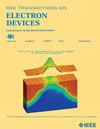A Physics-Based Analytical Model for Single-Event Multiple Transients Considering Well Potential Fluctuation
IF 2.9
2区 工程技术
Q2 ENGINEERING, ELECTRICAL & ELECTRONIC
引用次数: 0
Abstract
Due to factors such as the decreasing size of semiconductor processes and the threshold voltage of transistors, single-event transients (SETs) have the potential to develop into single-event multiple-transient (SEMT) effects. This study introduces an SEMT current model that accounts for the variability in the well potential to precisely characterize the multiple transient currents induced by a single particle. Through an examination of the alterations in physical parameters during SEMT occurrences, it is observed that fluctuations in the well potential can impact the collection of deposited charges and trigger the parasitic bipolar amplification effect. A physics-based SEMT current model is consequently formulated based on the underlying physical mechanisms. Verification of the proposed model is conducted through TCAD simulations, with 3-D simulation outcomes illustrating the efficacy of the analysis of physical mechanisms and model derivation under different linear energy transfers (LETs) and angles. Additionally, a 3-D three-stage inverter chain is assembled to confirm the model’s effectiveness in circuit-level simulation. The results indicate that the proposed model can accurately predict the critical LET. Notably, the simulation outcomes in SPICE, utilizing the proposed physical model, exhibit strong agreement with TCAD simulation results across various incident locations. And SPICE simulation could predict single-event double transients (SEDTs) under certain conditions, which is consistent with TCAD simulation.考虑井势波动的单事件多瞬态物理分析模型
由于半导体工艺尺寸的减小和晶体管的阈值电压等因素的影响,单事件瞬态(set)有可能发展成单事件多瞬态(SEMT)效应。该研究引入了一个SEMT电流模型,该模型考虑了井电位的可变性,以精确表征单个粒子引起的多个瞬态电流。通过检查SEMT发生期间物理参数的变化,观察到井电位的波动会影响沉积电荷的收集,并触发寄生双极放大效应。因此,基于物理的SEMT电流模型是基于潜在的物理机制制定的。通过TCAD仿真对提出的模型进行了验证,三维仿真结果说明了不同线性能量传递(let)和角度下物理机制分析和模型推导的有效性。此外,还组装了一个三维三级逆变器链,以验证该模型在电路级仿真中的有效性。结果表明,该模型能较准确地预测临界LET。值得注意的是,SPICE中使用所提出的物理模型的模拟结果与TCAD在不同事件地点的模拟结果非常一致。SPICE模拟可以在一定条件下预测单事件双瞬态(SEDTs),与TCAD模拟结果一致。
本文章由计算机程序翻译,如有差异,请以英文原文为准。
求助全文
约1分钟内获得全文
求助全文
来源期刊

IEEE Transactions on Electron Devices
工程技术-工程:电子与电气
CiteScore
5.80
自引率
16.10%
发文量
937
审稿时长
3.8 months
期刊介绍:
IEEE Transactions on Electron Devices publishes original and significant contributions relating to the theory, modeling, design, performance and reliability of electron and ion integrated circuit devices and interconnects, involving insulators, metals, organic materials, micro-plasmas, semiconductors, quantum-effect structures, vacuum devices, and emerging materials with applications in bioelectronics, biomedical electronics, computation, communications, displays, microelectromechanics, imaging, micro-actuators, nanoelectronics, optoelectronics, photovoltaics, power ICs and micro-sensors. Tutorial and review papers on these subjects are also published and occasional special issues appear to present a collection of papers which treat particular areas in more depth and breadth.
 求助内容:
求助内容: 应助结果提醒方式:
应助结果提醒方式:


